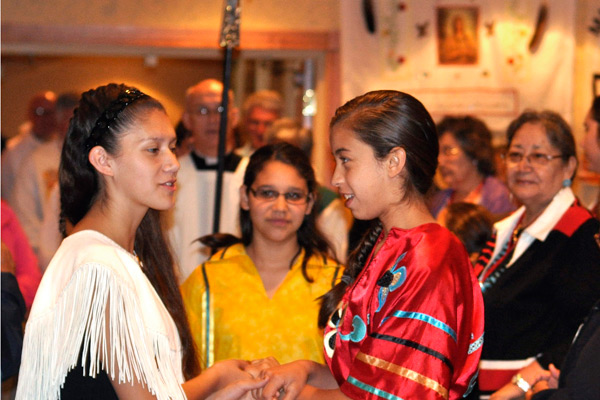
ALBANY, N.Y. (CNS) — Throughout the Tekakwitha Conference, the smell of burning sweet grass — known among native peoples as the “hair of mother earth” — wafted through Masses as congregants approached altars offering corn, beans and squash with the Eucharist.
Musicians played flutes, horn rattles and tree-bark water drums while chanting in native languages.
Performers and speakers re-enacted the Iroquois creation story; made cases for environmental stewardship; delivered monologues from the perspective of Blessed Kateri Tekakwitha; and read poetry praising the conference's patroness, who will be canonized in October.
Several dozen children learned to make rosaries and dance with hoops while adults debated how to engage native youth as conference membership grays.
More than 800 Native American Catholics converged in Albany July 18-22 for the 73rd annual conference. Besides attending workshops and liturgies, attendees made pilgrimages to two shrines in other locations in the Albany Diocese — the birth and baptismal places of Blessed Kateri in Auriesville and Fonda, respectively.
Ambrosia Redwillow, an 11-year-old member of the Oglala Lakota tribe living in urban Denver, “got to learn about what being Catholic and Native American means,” she said. “It means believing in God, and native means it's in your blood.
“You can be both,” Ambrosia continued, hitting on an oft-cited tension between staying true to tribal culture, which may include a separate set of spiritual beliefs, while being a good Catholic. “You don't have to be ashamed of being both.”
Ambrosia doesn't know many other Native Americans. Though this makes her feel “unique,” the conference “makes me happy because now I feel like I'm not the only one.”
She said Blessed Kateri's upcoming canonization is “really special. She's the first Native American. She told herself she can do it, and I'm proud of her.
“I know that all natives can be saints, and I can believe in Jesus no matter what anybody tells (me),” Ambrosia continued. “She was teased because people thought she believed in something that doesn't really exist. She not only helped her tribe learn about Jesus, but she helped others, and she didn't stop believing in God.”
Ambrosia said she once channeled Blessed Kateri's perseverance to stand up to a bully: “I was afraid. But I just said, 'Jesus Christ is by my side,' and I felt better.”
David Ciampichini, from Summit, N.J., is not Native American, but he also follows Blessed Kateri's example.
“To me, she means survival and struggle and overcoming,” said Ciampichini, an artist whose depiction of the Mohawk maiden was selected as the Tekakwitha Conference's logo. In multiple paintings, Ciampichini portrays Blessed Kateri as physically beautiful, despite records saying her face was pock-marked as a result of smallpox.
He said his depiction is a manifestation of her internal beauty and reports that her blemishes had miraculously disappeared after she died.
“It's just thrilling that she's the first Native American saint,” he said. “This young girl who wasn't even really known in her lifetime will be known worldwide. It really speaks to the sacredness of the individual and respect for the weak or those who are marginalized.”
Caroline Zhuckkahosee, a Jemez and Sandia Pueblo living on a reservation in Sandia, N.M., said the annual conferences refresh her and help her work out problems.
“It's a wholesome place for me to integrate with other tribes,” she said. “It's like a healing process. It's just like going to a counseling session.”
Zhuckkahosee came with 34 others from her parish's Kateri Circle, which has prayed for Blessed Kateri's canonization for years.
“Our day finally came,” she said. “I see the faith really growing.”
– – –
— By Angela Cave, a staff writer at The Evangelist, newspaper of the Diocese of Albany.






